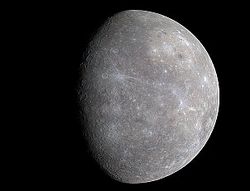Mercury
 This Fenspace article is a stub. You can help FenWiki by expanding it.
This Fenspace article is a stub. You can help FenWiki by expanding it.
| Mercury | |
 | |
| Planetary characteristics | |
|---|---|
| Orbit | 57,910,000 |
| Diameter | 4,880 km (equatorial) |
| Surface Gravity | 0.38G |
| Year | 87.96 days |
| Day | 58.64 days |
| Mean Temperature | 179°C (354.2°F) |
| Atmosphere | none |
| Water/Ice Index | 0% |
| Population (2013) | n/a |
| Political Affiliation | n/a |
| Government | n/a |
| Capital | n/a |
Mercury, Venus, Earth, and Mars are terrestrial (rocky) planets. Among these, Mercury is an extreme: the smallest, the densest (after correcting for self-compression), the one with the oldest surface, the one with the largest daily variations in surface temperature - and the least explored.
Color differences on Mercury are subtle, but they reveal important information about the nature of the planet's surface material. A number of bright spots with a bluish tinge are visible in this image. These are relatively recent impact craters. Some of the bright craters have bright streaks (called "rays" by planetary scientists) emanating from them. Bright features such as these are caused by the presence of freshly crushed rock material that was excavated and deposited during the highly energetic collision of a meteoroid with Mercury to form an impact crater. The large circular light-colored area in the upper right of the image is the interior of the Caloris basin. Mariner 10 viewed only the eastern (right) portion of this enormous impact basin, under lighting conditions that emphasized shadows and elevation differences rather than brightness and color differences. MESSENGER has revealed that Caloris is filled with smooth plains that are brighter than the surrounding terrain, hinting at a compositional contrast between these geologic units. The interior of Caloris also harbors several unusual dark-rimmed craters, which are visible in this image. The MESSENGER science team is working with the 11-color images in order to gain a better understanding of what minerals are present in these rocks of Mercury's crust.
(Text courtesy NASA MESSENGER Probe website)
Known Places on or around Mercury
- various mining stations